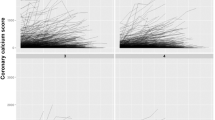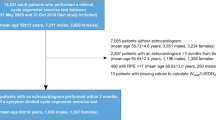Abstract
Background
The exercise test is a powerful non-invasive tool for risk stratifying patients with or suspected of having cardiovascular disease (CVD). Heart rate (HR) response during and following exercise has been extensively studied. However, the clinical utility of HR response at the onset of exercise is less understood. Furthermore, conflicting reports exist regarding whether a faster vs. slower HR acceleration represents a CVD risk marker. The primary study purpose was to describe HR acceleration early in exercise in apparently healthy individuals.
Methods
Retrospective analyses were performed in a sample (N = 947) representing a range of age and fitness (11–78 years; VO2peak 17–49 mL kg−1 min−1). HR response was defined over the initial 7 min of the protocol. Associations between HR acceleration and CVD risk factors were also assessed.
Results
Mean increases in HR were 18 ± 9 and 23 ± 11 beats at minute one, for men and women, respectively (p < 0.05). After adjusting for gender and pre-exercise HR, only modest associations were observed between the change in HR at minute one and body mass index, resting blood pressure, cigarette smoking, physical activity, HR reserve, and cardiorespiratory fitness.
Conclusion
There was wide variability in HR acceleration at the onset of exercise in this apparently healthy cohort. A lower increase in HR during the first minute of exercise was associated with a better CVD risk profile, including higher cardiorespiratory fitness, in apparently healthy individuals. These data suggest a greater parasympathetic influence at the onset of exercise may be protective in an asymptomatic population.

Similar content being viewed by others
Abbreviations
- ANS:
-
Autonomic nervous system
- BMI:
-
Body mass index
- BP:
-
Blood pressure
- BSU:
-
Ball State University
- Bpm:
-
Beats per minute
- CAD:
-
Coronary artery disease
- CI:
-
Chronotropic incompetence
- CVD:
-
Cardiovascular disease
- ECG:
-
Electrocardiogram
- GXT:
-
Graded exercise test
- HDL-C:
-
High-density lipoprotein cholesterol
- HR:
-
Heart rate
- LDL-C:
-
Low-density lipoprotein cholesterol
- MET:
-
Metabolic equivalents
- mg dl:
-
Milligram per deciliter
- min:
-
Minute
- mmHg:
-
Millimeters of mercury
- RER:
-
Respiratory exchange ratio
- RPE:
-
Ratings of perceived exertion
- VO2 :
-
Volume of oxygen
- SPECT:
-
Single photon emission computed tomography
References
American College of Sports Medicine (2013) ACSM’s guidelines for exercise testing and prescription, 9th edn. Wolters Kluwer/Lippincott Williams & Wilkins, Baltimore, p 456
Berne RM, Levy MN (1977) Cardiovascular physiology, 3rd edn. Mosby, Saint Louis
Chaitman B (2007) Should early acceleration of heart rate during exercise be used to risk stratify patients with suspected or established coronary artery disease? Circulation 115:430–431
Chin CF, Messenger JC, Greenberg PS, Ellestad MH (1979) Chronotropic incompetence in exercise testing. Clin Cardiol 2:12–18
Cole CR, Blackstone EH, Pashkow FJ, Snader CE, Lauer MS (1999) Heart-rate recovery immediately after exercise as a predictor of mortality. N Engl J Med 341:1351–1357
Cole CR, Foody JM, Blackstone EH, Lauer MS (2000) Heart rate recovery after submaximal exercise testing as a predictor of mortality in a cardiovascularly healthy cohort. Ann Intern Med 132:552–555
Ellestad MH (1996) Chronotropic incompetence: the implications of heart rate response to exercise (compensatory parasympathetic hyperactivity?). Circulation 93:1485–1487
Falcone C, Buzzi MP, Klersy C, Schwartz PJ (2005) Rapid heart rate increase at onset of exercise predicts adverse cardiac events in patients with coronary artery disease. Circulation 112:1959–1964
Fletcher GF, Ades PA, Kligfield P et al (2013) Exercise standards for testing and training: a scientific statement from the American Heart Association. Circulation 128:873–934
Gentlesk PJ, Markwood TT, Atwood JE (2004) Chronotropic incompetence in a young adult: case report and literature review. Chest 125:297–301
Go AS, Mozaffarian D, Roger VL et al (2013) Heart disease and stroke statistics––2013 update: a report from the American Heart Association. Circulation 127:e6–e245
Kaminsky LA, Whaley MH (1992) Evaluation of within-day precision of serum cholesterol measured by a portable analyzer. Med Sci Sports Exerc 24:134–138
Kaminsky LA, Whaley MH (1998) Evaluation of a new standardized ramp protocol: the BSU/Bruce ramp protocol. J Cardpulm Rehabil 18:438–444
Kligfield P, Lauer MS (2006) Exercise electrocardiogram testing: beyond the ST segment. Circulation 114:2070–2082
Lauer MS, Okin PM, Larson MG, Evans JC, Levy D (1996) Impaired heart rate response to graded exercise. Prognostic implications of chronotropic incompetence in the Framingham Heart Study. Circulation 93:1520–1526
Lauer MS, Pashkow FJ, Larson MG, Levy D (1997) Association of cigarette smoking with chronotropic incompetence and prognosis in the Framingham Heart Study. Circulation 96:897–903
Lauer M, Froelicher ES, Williams M, Kligfield P (2005) Exercise testing in asymptomatic adults: a statement for professionals from the American Heart Association Council on Clinical Cardiology, Subcommittee on Exercise, Cardiac Rehabilitation, and Prevention. Circulation 112:771–776
Leeper NJ, Dewey FE, Ashley EA et al (2007) Prognostic value of heart rate increase at onset of exercise testing. Circulation 115:468–474
Morshedi-Meibodi A, Larson MG, Levy D, O’Donnell CJ, Vasan RS (2002) Heart rate recovery after treadmill exercise testing and risk of cardiovascular disease events (The Framingham Heart Study). Am J Cardiol 90:848–852
Myers J, Buchanan N, Walsh D et al (1991) Comparison of the ramp versus standard exercise protocols. J Am Coll Cardiol 17:1334–1342
Myers J, Do D, Herbert W, Ribisl P, Froelicher VF (1994) A nomogram to predict exercise capacity from a specific activity questionnaire and clinical data. Am J Cardiol 73:591–596
Myers J, Tan SY, Abella J, Aleti V, Froelicher VF (2007) Comparison of the chronotropic response to exercise and heart rate recovery in predicting cardiovascular mortality. Eur J Cardiovasc Prev Rehabil 14:215–221
Nishime EO, Cole CR, Blackstone EH, Pashkow FJ, Lauer MS (2000) Heart rate recovery and treadmill exercise score as predictors of mortality in patients referred for exercise ECG. JAMA 284:1392–1398
Watanabe J, Thamilarasan M, Blackstone EH, Thomas JD, Lauer MS (2001) Heart rate recovery immediately after treadmill exercise and left ventricular systolic dysfunction as predictors of mortality: the case of stress echocardiography. Circulation 104:1911–1916
Whaley MH, Kaminsky LA (1999) Chronotropic incompetence in an apparently healthy, self referred middle-aged population. Med Sci Sports Exerc 31:S156
Whaley MH, Kaminsky LA (2007) Heart rate recovery in an asymptomatic, self-referred adult cohort. Med Sci Sports Exerc 39:S240
Whaley MH, Kaminsky LA, Dwyer GB, Getchell LH, Norton JA (1992a) Predictors of over- and underachievement of age-predicted maximal heart rate. Med Sci Sports Exerc 24:1173–1179
Whaley MH, Kaminksy LA, Getchell LH, Kelly MD, Treloar JH (1992b) Changes in total cholesterol following endurance training: a function of initial values. J Cardpulm Rehabil 12:42–50
Whaley MH, Kaminsky LA, Dwyer GB, Getchell LH (1995) Failure of predicted VO2peak to discriminate physical fitness in epidemiological studies. Med Sci Sports Exerc 27:85–91
Acknowledgments
This research received no specific grant from any funding agency in the public, commercial, or not-for-profit sectors.
Conflict of interest
The authors declare that there is no conflict of interest.
Author information
Authors and Affiliations
Corresponding author
Additional information
Communicated by Klaas R. Westerterp and Håkan Westerblad.
Rights and permissions
About this article
Cite this article
Jagoda, A., Myers, J.N., Kaminsky, L.A. et al. Heart rate response at the onset of exercise in an apparently healthy cohort. Eur J Appl Physiol 114, 1367–1375 (2014). https://doi.org/10.1007/s00421-014-2867-0
Received:
Accepted:
Published:
Issue Date:
DOI: https://doi.org/10.1007/s00421-014-2867-0




